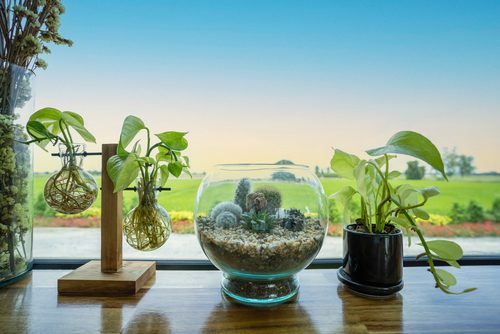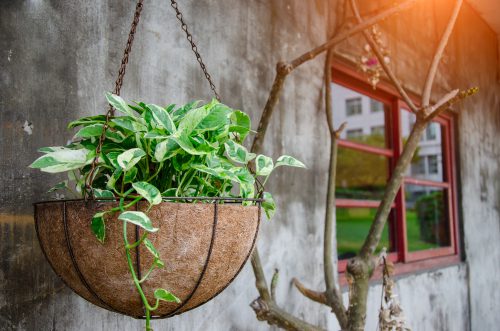Epipremnum aureum can be found in almost every home of every nature lover. You may also know the plant as scindapsus, devil’s ivy, pothos, ceylon creeper, hunter’s robe, ivy arum, money plant or taro vine. You see them all around for the simple reason that they survive in nearly every condition and flourish. This makes epipremnum aureum a new gardener’s best bet. The heart-shaped, glossy, medium-green leaves of the plant are variegated with a paler green underside that turns a dull living space into a vibrant one.
This guide would provide all the information about devil’s ivy and the detailed process to care for this evergreen, low-maintenance, NASA-recommended air-purifying perennial indoor plants.
Epipremnum aureum: The plant

This low-maintenance, easy-on-the-eye plant with glossy green leaves and cream and yellow streaks and blotches, can adorn any part of your home.
Also read all about Spider plant Vastu direction and maintenance tips
Epipremnum aureum: Fact sheet

| Botanical name: Epipremnum aureum
Genus: Epipremnum Species: Aureum Family: Araceae Native: French Polynesia and the Solomon Islands Life cycle: Perennial Propagation: Stem-cutting Climbing method: Scrambler Height: Up to 20 m Soil type: Well drained Light: Full sun Watering: When the first quarter inch of soil begins to feel dry Maintenance: Low Ideal to be grown in: Containers, hanging baskets, vertical spaces Flowering: Rare Poisonous: Humans, cats, dogs, horses Poison symptoms: Pain and swelling in the mouth, excessive drooling, vomiting, difficulty swallowing, skin irritation, diarrhoea |
Also read all about Jade plants benefits
How to grow and care for epipremnum aureum?

From growing it in a hanging basket to trailing it down from a high shelf, there are several ways to add this perennial inside your home. All it needs is a moss-covered pole to keep growing. If you have this leafy climber at home, you need to care for it too.
Light: Devil’s ivy requires partial light all through the year. Its leaves would begin to lose sheen and texture if exposed to excess light.
Temperature: The ideal temperature for your money plant is between 15-29ºC. While it can withstand a dip in temperature, it would die at a temperature below 10ºC.
Soil: Well-draining soil is perfect for epipremnum aureum.
Watering: Like most house plants, this one requires watering only when the first quarter inch of the soil goes dry.
Fertiliser: Fertilising is needed only if the soil quality is poor. Otherwise, the plant would grow on its own. From spring to summer, feed your plant every two weeks with a balanced liquid fertiliser. Use the fertiliser sparingly during winter.
Propagation: Propagation is best done through cuttings. Just cut a section of the parent plant. Submerge the cutting into the water for two weeks. Once roots start to show, transfer the cutting to a container.

See also: ZZ plant benefits and maintenance tips
Possible problems with your Epipremnum Aureum
- Over-watering will result in the leaves turning yellow.
- Over-watering would also result in rotting of roots.
- Leaves will turn limp in case of drop in temperature.
- Artificial misting is required if your home conditions are dry. In case of a lack of proper humidity, the tips of the leaves would turn brown.
FAQs
Is epipremnum aureum poisonous?
Yes, its foliage and sap are toxic and may cause mouth and skin irritation, if consumed.
What is the common name used for pothos in India?
Pothos is commonly known as the money plant in most Indian households.
Does epipremnum aureum have air purifying properties?
Yes, epipremnum aureum is known to be highly effective as an air purifier, reducing the most common house air pollutants like benzene, formaldehyde, trichloroethylene, xylene and toluene.







